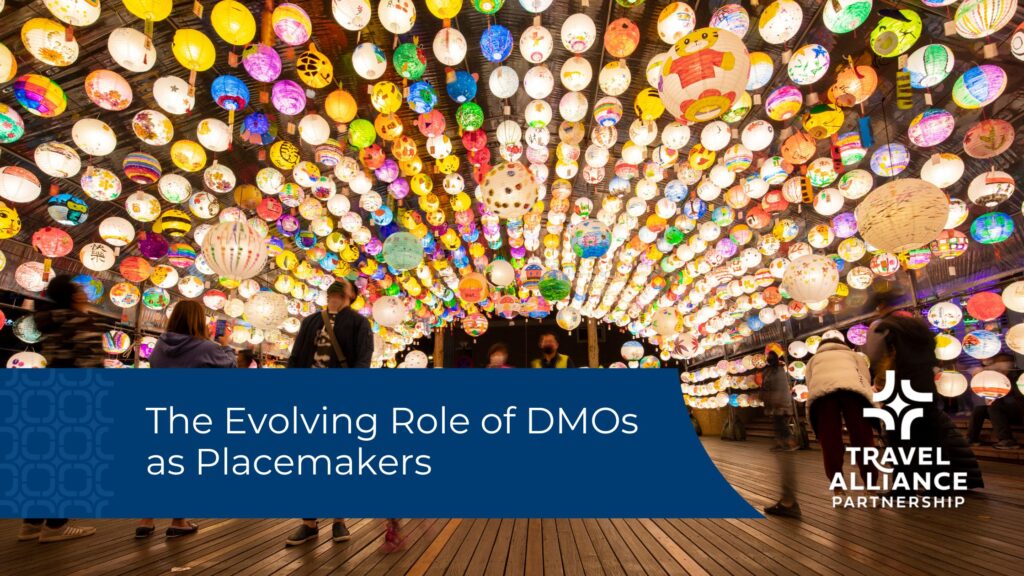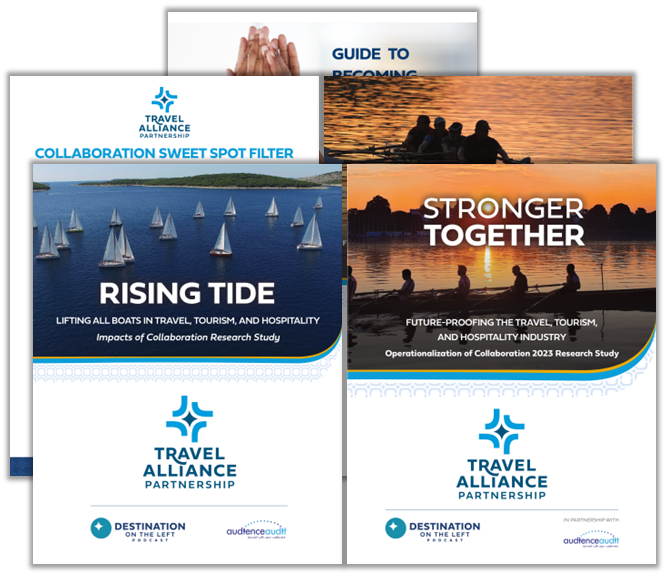The Evolving Role of DMOs as Placemakers
In recent years, many DMOs have embraced a more holistic approach to managing a destination’s brand and narrative. While the acronym ‘DMO’ traditionally stands for Destination Marketing Organization, an increasing number are now officially recognized as Destination Management Organizations. This shift reflects a broader mandate extending well beyond attracting visitors. Today, DMOs are emerging as placemakers: driving sustainable economic growth, fostering local collaboration, and creating vibrant communities.
Let’s explore some examples of collaborations central to destination management and placemaking, and what this means for the tourism industry.

Understanding DMOs, DMCs, and CVBs
Before we dig into their evolution, it’s helpful to clarify the difference between DMOs and other related organizations:
- DMO (Destination Marketing Organization or Destination Management Organization): DMOs are tasked with branding and promoting a destination to attract visitors. While traditionally marketing-focused, many now also focus on managing the destination experience, fostering collaboration between stakeholders, and ensuring sustainable growth.
- DMC (Destination Management Company): Unlike DMOs, which are publicly funded and focus on the broader destination, DMCs are private entities that organize and coordinate specific local events, travel experiences, or group activities. Think of them as operational experts that craft personalized itineraries, often for inbound tourism groups or businesses that aren’t familiar with the area.
- CVB (Convention and Visitors Bureau): A subtype of a DMO, CVBs work primarily to attract meetings, conferences, and conventions to a specific area, often collaborating with local hotels and event venues.
While their roles may overlap, DMOs focus on strategic, destination-wide initiatives, DMCs curate tailored experiences, and CVBs concentrate on boosting event tourism.
Marketing to Leadership
The transition from being purely marketing-driven to playing a leadership role lies at the heart of the DMO’s evolution. Bill Geist, of DMOproZ, envisions a future where DMOs rebrand as “Destination Leadership Organizations” (DLOs). These organizations would not just promote destinations but provide a voice at the table for key discussions on economic development, urban planning, and the overall well-being of residents.
Learn more about this concept in Episode 115 of Destination on the Left podcast, “From Destination Marketing to Destination Leadership”.
Leadership through Storytelling
Peter Kageyama is an author of two books For the Love of Cities: The Love Affair Between People and Their Places and Love Where You Live: Creating Emotionally Engaging Places. In these, he talks about the entrepreneurial culture in cities, and calls the entrepreneurs “co-creators of these cities.” Bill Geist sees a role for DMOs to help pull these co-creators together by weaving their stories into the brand. One way this may play out is through the use of social media, video and blogs. Who better to tell those stories than the organization that is great at telling the story of a destination?
Visitors as Future Residents
In Episode 128 of Destination on the Left with David Gilbert, CEO of Destination Cleveland, he refers to the 1 million visitors that Cleveland sees each year as “first dates.” With over a million visitors annually, Cleveland uses its tourism strategy to spark long-term relationships. By introducing visitors to the city’s culture and opportunities, Destination Cleveland has encouraged talent recruitment, student enrollment, and even population growth.
Their “#ComebacktoCLE” campaign is a perfect example. This initiative targeted former residents, transforming nostalgia into action by highlighting the city’s current opportunities. The success of such strategies shows how DMOs can think about tourism beyond dollars spent today and see it as an investment in their community’s future.
What strategies could your city or region implement to make visitors feel like future residents?
Tourism and Economic Development
Tourism and economic development often go hand-in-hand. In Episode 117 of Destination on the Left, I had the opportunity to interview Connie Stopher and Melissa Barry from Southern Idaho. At the time of the interview, they were the Executive Director of the Southern Idaho Economic Development Organization and Executive Director of Southern Idaho Tourism, respectively. Both on the show at the same time spoke volumes about how intertwined these organizations are, exemplifying this relationship. Collaborative efforts between Southern Idaho Tourism and the local economic development organization have not only attracted visitors but also successfully invited new residents and businesses to the area.
This example highlights a critical insight for DMOs evolving into placemakers: They must view everyone as a potential stakeholder. Visitors one day can become students, employees, or even business owners in the future.
The impact extends further when partnerships focus on sustainability. Southern Idaho’s approach to protecting natural resources while promoting tourism ensures that development meets the needs of both visitors and locals. A flourishing visitor economy, when paired with sustainable practices, drives long-term community well-being.
Lessons from the Pandemic
The COVID-19 pandemic forced DMOs to adapt in ways never seen before. Take the Finger Lakes Visitor Connection (FLVC) as an example. During the crisis, Valerie Knoblauch and her team at FLVC pivoted from tourism promotion to helping its local community survive.
By partnering with the Ontario County Economic Development Corporation, FLVC used their communication expertise to address and assist with massive job loss and businesses closing in their community.
A New Approach to Economic Development
Traditionally, economic development offices look to build up small businesses through financial programs with low-interest loans. FLVC understood these businesses did not need more debt, they needed to generate revenue by re-opening and getting customers back in the door.
The community-wide goal was to have all industries re-open effectively and efficiently. By taking the burden of working through the new protocols off small business owners, they could focus on figuring out the core operations of their businesses.
The Results of Collaboration
Awareness of the FLVC increased through its major role in the community during the pandemic. For the first time, the organization was invited to the table to work with partners different from those they had in the past. This increased awareness led to stronger programs in the future.
Through this collaboration, new county-wide partnerships helped FLVC continue creating community impact in a post-pandemic world. The pandemic brought the organization together with Chambers of Commerce, Business Improvement Districts, Economic Development officials, city and town governments, and others.
Looking Ahead
By thinking more broadly about their role as a placemaker, DMOs can build stronger, more resilient communities. Those willing to pivot and adopt a more holistic approach can lead the way in creating destinations where people truly want to live, work, and play, while ensuring that these communities grow responsibly and inclusively.
How do you see the future of DMOs evolving in your community? Join the conversation and explore these ideas further by tuning into Destination on the Left and joining the Facebook group. Let’s discuss how collaboration and leadership can redefine destinations for years to come!
Author
Related Posts
What is Accessibility in Tourism?
Travel is an incredibly life-enriching and rewarding experience, yet it is still inaccessible to many people. About 15 percent of the world’s population live with…
Impacts DMOs Make Through Community Partnerships
I have been working as a strategic partner to Destination Marketing Organizations (DMOs) for more than 15 years. Over that time, I watched the role…
